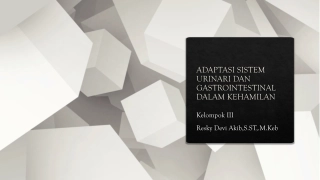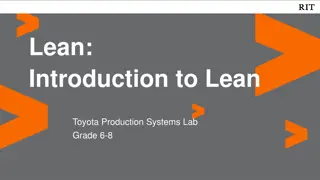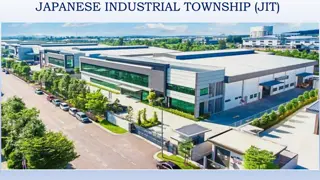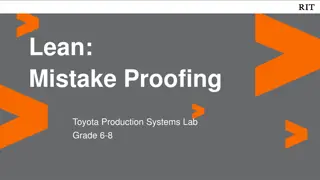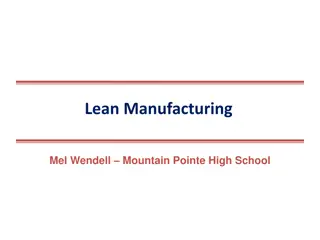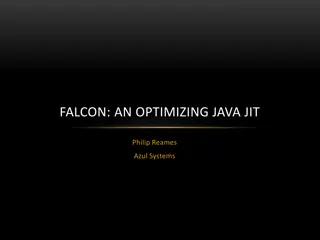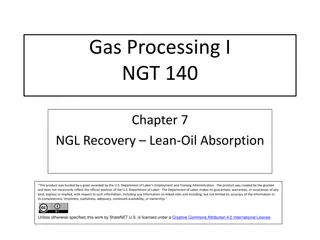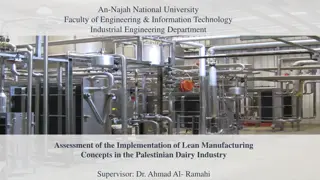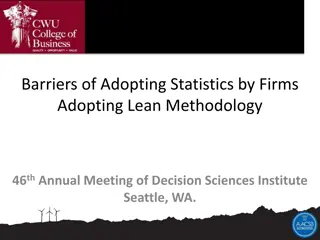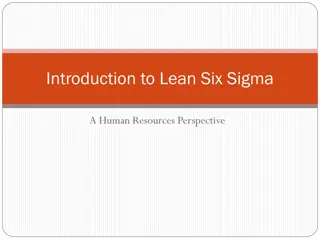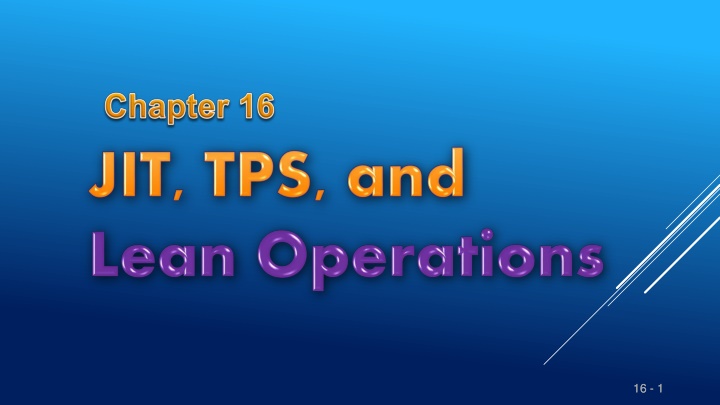
Toyota Motor Corporation: JIT, TPS, and Lean Operations Explained
Explore the world of Toyota Motor Corporation and learn about Just-in-Time (JIT), Toyota Production System (TPS), and Lean Operations. Uncover the principles behind these techniques, the success story of Toyota, and the fundamental elements of TPS. Discover how JIT, TPS, and Lean Operations focus on waste elimination, continuous improvement, and enhancing customer understanding. Get insights into the innovative strategies that have made Toyota a global leader in the automotive industry.
Uploaded on | 0 Views
Download Presentation

Please find below an Image/Link to download the presentation.
The content on the website is provided AS IS for your information and personal use only. It may not be sold, licensed, or shared on other websites without obtaining consent from the author. If you encounter any issues during the download, it is possible that the publisher has removed the file from their server.
You are allowed to download the files provided on this website for personal or commercial use, subject to the condition that they are used lawfully. All files are the property of their respective owners.
The content on the website is provided AS IS for your information and personal use only. It may not be sold, licensed, or shared on other websites without obtaining consent from the author.
E N D
Presentation Transcript
16 - 1 16 - 1
Outline Global Company Profile: Toyota Motor Corporation Just-in-Time, the Toyota Production System, and Lean Operations Just-in-Time (JIT) Toyota Production System (TPS) Lean Operations Lean Operations in Services 16 - 2 16 - 2
Learning Objectives When you complete this chapter you should be able to: Define just-in-time, TPS, and lean operations Define the seven wastes and the 5Ss Explain JIT partnerships Determine optimal setup time 1. 2. 3. 4. 16 - 3 16 - 3
Learning Objectives When you complete this chapter you should be able to: Define kanban Compute the required number of kanbans Explain the principles of the Toyota Production System 5. 6. 7. 16 - 4 16 - 4
Toyota Motor Corporation Largest vehicle manufacturer in the world with annual sales of over 9 million vehicles Success due to two techniques, JIT and TPS Continual problem solving is central to JIT Eliminating excess inventory makes problems immediately evident 16 - 5 16 - 5
Toyota Motor Corporation Central to TPS is employee learning and a continuing effort to produce products under ideal conditions Respect for people is fundamental Small building but high levels of production Subassemblies are transferred to the assembly line on a JIT basis High quality and low assembly time per vehicle 16 - 6 16 - 6
TPS Elements 16 - 7 16 - 7
JIT/TPS/Lean Operations Good production systems require that managers address three issues that are pervasive and fundamental to operations management: eliminate waste, remove variability, and improve throughput 16 - 8 16 - 8
Just-In-Time, TPS, and Lean Operations o JIT focuses on continuous forced problem solving o TPS emphasizes continuous improvement, respect for people, and standard work practices in an assembly-line environment o Lean operations emphasize understanding the customer 16 - 9 16 - 9
Eliminate Waste o Waste is anything that does not add value from the customer point of view o Storage, inspection, delay, waiting in queues, and defective products do not add value and are 100% waste 16 - 10 16 - 10
Ohnos Seven Wastes Overproduction Queues Transportation Inventory Motion Overprocessing Defective products 16 - 11 16 - 11
Eliminate Waste Other resources such as energy, water, and air are often wasted Efficient, sustainable production minimizes inputs, reduces waste Traditional housekeeping has been expanded to the 5Ss 16 - 12 16 - 12
The 5Ss Sort/segregate when in doubt, throw it out Simplify/straighten methods analysis tools Shine/sweep clean daily Standardize remove variations from processes Sustain/self-discipline review work and recognize progress 16 - 13 16 - 13
The 5Ss Sort/segregate when in doubt, throw it out Simplify/straighten methods analysis tools Shine/sweep clean daily Standardize remove variations from processes Sustain/self-discipline review work and recognize progress 16 - 14 16 - 14
Remove Variability JIT systems require managers to reduce variability caused by both internal and external factors o Variability is any deviation from the optimum process Inventory hides variability o Less variability results in less waste o 16 - 15 16 - 15
Sources of Variability o Poor production processes resulting in improper quantities, late, or non-conforming units o Unknown customer demands o Incomplete or inaccurate drawings, specifications, or bills of material 16 - 16 16 - 16
Sources of Variability o Poor production processes resulting in improper quantities, late, or non-conforming units o Unknown customer demands o Incomplete or inaccurate drawings, specifications, or bills of material 16 - 17 16 - 17
Improve Throughput The time it takes to move an order from receipt to delivery The time between the arrival of raw materials and the shipping of the finished order is called manufacturing cycle time A pull system increases throughput 16 - 18 16 - 18
Improve Throughput By pulling material in small lots, inventory cushions are removed, exposing problems and emphasizing continual improvement Manufacturing cycle time is reduced Push systems dump orders on the downstream stations regardless of the need 16 - 19 16 - 19
Just-In-Time (JIT) o Powerful strategy for improving operations o Materials arrive where they are needed when they are needed o Identifying problems and driving out waste reduces costs and variability and improves throughput o Requires a meaningful buyer-supplier relationship 16 - 20 16 - 20
JIT and Competitive Advantage Figure 16.1 16 - 21 16 - 21
JIT and Competitive Advantage Figure 16.1 16 - 22 16 - 22
JIT Partnerships JIT partnerships exist when a supplier and purchaser work together to remove waste and drive down costs Four goals of JIT partnerships are: o Removal of unnecessary activities o Removal of in-plant inventory o Removal of in-transit inventory o Improved quality and reliability 16 - 23 16 - 23
JIT Partnerships Figure 16.2 16 - 24 16 - 24
Concerns of Suppliers Diversification ties to only one customer increases risk Scheduling don t believe customers can create a smooth schedule Lead time short lead times mean engineering or specification changes can create problems Quality limited by capital budgets, processes, or technology Lot sizes small lot sizes may transfer costs to suppliers 16 - 25 16 - 25
JIT Layout Reduce waste due to movement TABLE 16.1 JIT LAYOUT TACTICS Build work cells for families of products Include a large number operations in a small area Minimize distance Design little space for inventory Improve employee communication Use poka-yoke devices Build flexible or movable equipment Cross-train workers to add flexibility 16 - 26 16 - 26
Distance Reduction Large lots and long production lines with single- purpose machinery are being replaced by smaller flexible cells Often U-shaped for shorter paths and improved communication Often using group technology concepts 16 - 27 16 - 27
Increased Flexibility Cells designed to be rearranged as volume or designs change Applicable in office environments as well as production settings Facilitates both product and process improvement 16 - 28 16 - 28
Impact on Employees Employees may be cross trained for flexibility and efficiency Improved communications facilitate the passing on of important information about the process With little or no inventory buffer, getting it right the first time is critical 16 - 29 16 - 29
Reduced Space and Inventory With reduced space, inventory must be in very small lots Units are always moving because there is no storage 16 - 30 16 - 30
JIT Inventory Inventory is at the minimum level necessary to keep operations running TABLE 16.2 JIT INVENTORY TACTICS Use a pull system to move inventory Reduce lot sizes Develop just-in-time delivery systems with suppliers Deliver directly to point of use Perform to schedule Reduce setup time Use group technology 16 - 31 16 - 31
Reduce Variability Inventory level Process downtime Scrap Setup time Quality problems Late deliveries Figure 16.3 16 - 32 16 - 32
Reduce Variability Inventory level Process downtime Scrap Setup time Quality problems Late deliveries Figure 16.3 16 - 33 16 - 33
Reduce Variability Inventory level No scrap Quality problems removed Setup time reducedNo late deliveries Process downtime removed Figure 16.3 16 - 34 16 - 34
Reduce Inventory Reducing inventory uncovers the rocks Problems are exposed Ultimately there will be virtually no inventory and no problems Inventory Shingo says Inventory is evil 16 - 35 16 - 35
Reduce Lot Sizes Figure 16.4 Q1 When average order size = 200 average inventory is 100 Inventory 200 Q2 When average order size = 100 average inventory is 50 100 Time 16 - 36 16 - 36
Reduce Lot Sizes Ideal situation is to have lot sizes of one pulled from one process to the next Often not feasible Can use EOQ analysis to calculate desired setup time Two key changes necessary o Improve material handling 2DS *= Qp H 1-(d / p) o Reduce setup time 16 - 37 16 - 37
Lot Size Example D = Annual demand = 400,000 units d = Daily demand = 400,000/250 = 1,600 per day p = Daily production rate = 4,000 units Q = EOQ desired = 400 H = Holding cost = $20 per unit S = Setup cost (to be determined) 2DS 2DS *= Q2= Qp H 1-(d / p) ( )1-d / p ( 2D H 1-(d / p) ( )H ) Q2 =(400)2(20)(1-1,600/ 4,000) 2(400,000) S = =$2.40 Setup time = $2.40/($30/hour) = 0.08 hr = 4.8 minutes 16 - 38 16 - 38
Reduce Setup Costs o High setup costs encourage large lot sizes o Reducing setup costs reduces lot size and reduces average inventory o Setup time can be reduced through preparation prior to shutdown and changeover 16 - 39 16 - 39
Lower Setup Costs Figure 16.5 Holding cost Sum of ordering and holding costs Cost T1 Setup cost curve (S2) T2 Setup cost curve (S1) S1 S2 Lot size 16 - 40 16 - 40
Reduce Setup Costs Figure 16.6 90 min Initial Setup Time Separate setup into preparation and actual setup, doing as much as possible while the machine/process is operating (save 30 minutes) Step 1 60 min Move material closer and improve material handling (save 20 minutes) Step 2 45 min Standardize and improve tooling (save 15 minutes) Step 3 25 min Use one-touch system to eliminate adjustments (save 10 minutes) Training operators and standardizing work procedures (save 2 minutes) Repeat cycle until subminute setup is achieved Step 4 15 min 13 min Step 5 Step 6 16 - 41 16 - 41
JIT Scheduling Schedules must be communicated inside and outside the organization Level schedules o Process frequent small batches o Freezing the schedule helps stability Kanban o Signals used in a pull system 16 - 42 16 - 42
JIT Scheduling Better scheduling improves performance TABLE 16.3 JIT SCHEDULING TACTICS Communicate schedules to suppliers Make level schedules Freeze part of the schedule Perform to schedule Seek one-piece-make and one-piece move Eliminate waste Produce in small lots Use kanbans Make each operation produce a perfect part 16 - 43 16 - 43
Level Schedules o Process frequent small batches rather than a few large batches o Make and move small lots so the level schedule is economical o Freezing the schedule closest to the due dates can improve performance 16 - 44 16 - 44
Scheduling Small Lots Figure 16.7 JIT Level Material-Use Approach B B B B B B A A C A A C Large-Lot Approach B B B B B B B B B A A A A A A C C C Time 16 - 45 16 - 45
Kanban Kanban is the Japanese word for card The card is an authorization for the next container of material to be produced A sequence of kanbans pulls material through the process Many different sorts of signals are used, but the system is still called a kanban 16 - 46 16 - 46
Kanban Figure 16.8 Signal marker hanging on post for part Z405 shows that production should start for that part. The post is located so that workers in normal locations can easily see it. Signal marker on stack of boxes Part numbers mark location of specific part 16 - 47 16 - 47
Kanban Material/Parts Supplier Final assembly Finished goods Customer order Work cell Kanban Kanban Kanban 16 - 48 16 - 48
More Kanban o When the producer and user are not in visual contact, a card can be used; otherwise, a light or flag or empty spot on the floor may be adequate o Usually each card controls a specific quantity or parts although multiple card systems may be used if there are several components or if the lot size is different from the move size 16 - 49 16 - 49
More Kanban o Kanban cards provide a direct control and limit on the amount of work-in-process between cells o If there is an intermediate storage area, a two-card system can be used with one card circulating between the user and storage area and the other between the storage area and the producing area 16 - 50 16 - 50

